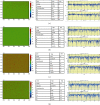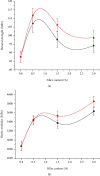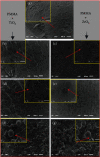Influence of the Physical Inclusion of ZrO2/TiO2 Nanoparticles on Physical, Mechanical, and Morphological Characteristics of PMMA-Based Interim Restorative Material
- PMID: 36033557
- PMCID: PMC9417768
- DOI: 10.1155/2022/1743019
Influence of the Physical Inclusion of ZrO2/TiO2 Nanoparticles on Physical, Mechanical, and Morphological Characteristics of PMMA-Based Interim Restorative Material
Retraction in
-
Retracted: Influence of the Physical Inclusion of ZrO2/TiO2 Nanoparticles on Physical, Mechanical, and Morphological Characteristics of PMMA-Based Interim Restorative Material.Biomed Res Int. 2024 Jan 9;2024:9876827. doi: 10.1155/2024/9876827. eCollection 2024. Biomed Res Int. 2024. PMID: 38230118 Free PMC article.
Abstract
Polymethyl methacrylate (PMMA) is often used in restorative dentistry for its easy fabrication, aesthetics, and low cost for interim restorations. However, poor mechanical properties to withstand complex masticatory forces are a concern for clinicians. Therefore, this study aimed to modify a commercially available PMMA-based temporary restorative material by adding TiO2 and ZrO2 nanoparticles in different percentages as fillers and to investigate its physio-mechanical properties. Different percentages (0, 0.5, 1.5, and 3.0 wt%) of TiO2 and ZrO2 nanoparticles were mixed with the pristine PMMA resin (powder to liquid ratio: 1 : 1) and homogenized using high-speed mixer. The composites obtained were analyzed for their flexural strength (F.S.), elastic modulus (E.M.), Vickers hardness (H.V.), surface roughness Ra, morphology and water contact angle (WCA). The mean average was determined with standard deviation (SD) to analyze the results, and a basic comparison test was conducted. The results inferred that adding a small amount (0.5 wt%) of TiO2 and ZrO2 nanoparticles (NPs) could significantly enhance the physio-mechanical and morphological characteristics of PMMA interim restorations. EM and surface hardness increased with increasing filler content, with 3.0 wt.% ZrO2 exhibiting the highest EM (3851.28 MPa), followed by 3.0 wt.% TiO2 (3632.34 MPa). The WCA was significantly reduced from 91.32 ± 4.21° (control) to 66.30 ± 4.23° for 3.0 wt.% ZrO2 and 69.88 ± 3.55° for 3.0 wt.% TiO2. Therefore, TiO2 and ZrO2 NPs could potentially be used as fillers to improve the performance of PMMA and similar interim restorations.
Copyright © 2022 Ali Alrahlah et al.
Conflict of interest statement
The authors declare no conflict of interest.
Figures







Similar articles
-
Flexural Strength and Hardness of Filler-Reinforced PMMA Targeted for Denture Base Application.Materials (Basel). 2021 May 19;14(10):2659. doi: 10.3390/ma14102659. Materials (Basel). 2021. PMID: 34069482 Free PMC article.
-
Effect of zirconium oxide nanoparticles addition on the optical and tensile properties of polymethyl methacrylate denture base material.Int J Nanomedicine. 2018 Jan 9;13:283-292. doi: 10.2147/IJN.S152571. eCollection 2018. Int J Nanomedicine. 2018. PMID: 29391789 Free PMC article.
-
Investigating the Mechanical Properties of ZrO2-Impregnated PMMA Nanocomposite for Denture-Based Applications.Materials (Basel). 2019 Apr 25;12(8):1344. doi: 10.3390/ma12081344. Materials (Basel). 2019. PMID: 31027157 Free PMC article.
-
The Effect of Zirconium Dioxide (ZrO2) Nanoparticles Addition on the Mechanical Parameters of Polymethyl Methacrylate (PMMA): A Systematic Review and Meta-Analysis of Experimental Studies.Polymers (Basel). 2022 Mar 6;14(5):1047. doi: 10.3390/polym14051047. Polymers (Basel). 2022. PMID: 35267870 Free PMC article. Review.
-
Effect of addition of titanium dioxide nanoparticles on the antimicrobial properties, surface roughness and surface hardness of polymethyl methacrylate: A Systematic Review.F1000Res. 2023 May 31;12:577. doi: 10.12688/f1000research.130028.1. eCollection 2023. F1000Res. 2023. PMID: 37424742 Free PMC article.
Cited by
-
Mechanical and Biological Characterization of PMMA/Al2O3 Composites for Dental Implant Abutments.Polymers (Basel). 2023 Jul 27;15(15):3186. doi: 10.3390/polym15153186. Polymers (Basel). 2023. PMID: 37571080 Free PMC article.
-
Retracted: Influence of the Physical Inclusion of ZrO2/TiO2 Nanoparticles on Physical, Mechanical, and Morphological Characteristics of PMMA-Based Interim Restorative Material.Biomed Res Int. 2024 Jan 9;2024:9876827. doi: 10.1155/2024/9876827. eCollection 2024. Biomed Res Int. 2024. PMID: 38230118 Free PMC article.
-
Biocompatibility and antimicrobial properties of titanium and Zirconium-infused denture base resins.Bioinformation. 2024 Oct 31;20(10):1345-1349. doi: 10.6026/9732063002001345. eCollection 2024. Bioinformation. 2024. PMID: 40092867 Free PMC article.
-
Photocatalytic Synthesis of Materials for Regenerative Medicine Using Complex Oxides with β-pyrochlore Structure.Life (Basel). 2023 Jan 28;13(2):352. doi: 10.3390/life13020352. Life (Basel). 2023. PMID: 36836711 Free PMC article.
-
Impact of Nanoparticle Addition on the Surface and Color Properties of Three-Dimensional (3D) Printed Polymer-Based Provisional Restorations.Nanomaterials (Basel). 2024 Apr 11;14(8):665. doi: 10.3390/nano14080665. Nanomaterials (Basel). 2024. PMID: 38668159 Free PMC article.
References
-
- Burns D. R., Beck D. A., Nelson S. K., Committee on Research in Fixed Prosthodontics of the Academy of Fixed Prosthodontics A review of selected dental literature on contemporary provisional fixed prosthodontic treatment: report of the committee on research in fixed prosthodontics of the academy of fixed prosthodontics. The Journal of Prosthetic Dentistry . 2003;90(5):474–497. doi: 10.1016/S0022-3913(03)00259-2. - DOI - PubMed
-
- Valkov B., Balcheva M. Temporary filling materials in endodontics—a literature review. Scripta Scientifica Medicinae Dentalis . 2022;8(1)
Publication types
MeSH terms
Substances
LinkOut - more resources
Full Text Sources

